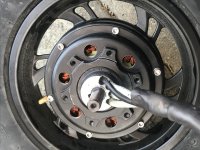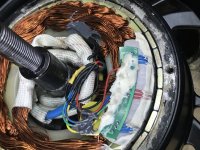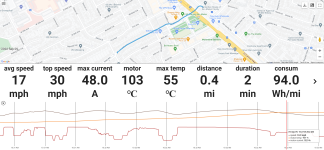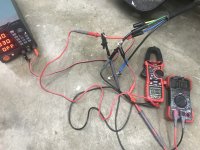chuyskywalker
1 kW
I've got a Fiido Q1S and it's got a small, but wants to be mighty, DD hub motor on it that I just can't seem to keep cool.

(Motor specs, as best I can find: site1, site2)
I have added statorade to the motor, it comes with vents I've left open, and I even drilled holes in the other plate -- yet I can't seem to keep this bad boy cool if I so much as even look at a hill.

I had to add a temp sensor (so annoying):

and I took time to validate that the temp readings coming back are good using a different temp sensor. It's within a few degrees, so all good.
I've got this hooked up to a Trampa 100/250 VESC with it set for up to 150 phase amps and a thermal cut off at 100C. When I push it, I find that it can only maintain a motor temp of 100C with 50-70A. That's mostly bench testing, though, with foc_openloop -- but even in the real it's very easy to hit the 100C mark just climbing slight grades. Worse, even riding flat lands I seem to be hovering around the 80C mark.
I've tried this on a 52v system and swapped into a 72v battery and gotten much the same results.
I'm a bit ruffled that I can't seem to get this to perform better and shed the heat more aggressively. Open to suggestions!

(Motor specs, as best I can find: site1, site2)
I have added statorade to the motor, it comes with vents I've left open, and I even drilled holes in the other plate -- yet I can't seem to keep this bad boy cool if I so much as even look at a hill.

I had to add a temp sensor (so annoying):

and I took time to validate that the temp readings coming back are good using a different temp sensor. It's within a few degrees, so all good.
I've got this hooked up to a Trampa 100/250 VESC with it set for up to 150 phase amps and a thermal cut off at 100C. When I push it, I find that it can only maintain a motor temp of 100C with 50-70A. That's mostly bench testing, though, with foc_openloop -- but even in the real it's very easy to hit the 100C mark just climbing slight grades. Worse, even riding flat lands I seem to be hovering around the 80C mark.
I've tried this on a 52v system and swapped into a 72v battery and gotten much the same results.
I'm a bit ruffled that I can't seem to get this to perform better and shed the heat more aggressively. Open to suggestions!




